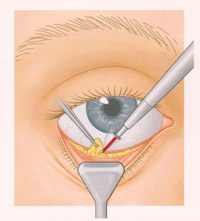When someone finds out I’m an ophthalmologist, 99% of the time their first question is, “Do you do that laser eye surgery?”…or something to that effect. Some marketing geniuses did a great job of associating eye surgery of any kind with precision lasers. Most people seem disappointed when I tell them I don’t do LASIK (I guess because they won’t be scoring a sweet discount). Lasers are frequently used in the eyelid surgery I perform and are regularly advertised as better than the standard surgical techniques (just drive down I-15 and you’ll see a half dozen billboards promoting laser surgery, usually depicting people who have never had or won’t soon need any surgery). So do lasers live up to the hype? Is surgery performed with a laser superior? The answer is a resounding maybe.
Where lasers excel: CO2 laser has been used for eyelid surgery since 1980, and was greatly improved in the 1990’s. It is extremely precise. When properly focused, the laser cuts, coagulates severed blood vessels, and can be used as a blunt dissecting instrument. This can greatly speed up the procedure. One study showed that a 4 eyelid surgery took 58 minutes on average with laser compared to 94 minutes with a blade. A separate study showed that patients returned to their normal activities after about 6 days following laser surgery compared to 9 days after scalpel surgery. In most cases, bleeding is very well controlled, which speeds up surgery and may result in less bruising post-operatively, even in patients on blood-thinners.
Where lasers suffer: When you cut with a blade, only the tissue directly incised is damaged. The adjacent skin and muscle is left intact and ready to aid in healing once the wound is closed. With a laser, a zone of coagulative necrosis (fancy for burned dead tissue) is created on either side of the cut. In order to heal, the body must first clear these dead cells and debris out of way before forming a healed scar. This will require a more intense inflammatory response with the possibility of a larger scar. The incision may also heal slower, leaving it at greater risk of opening back up inadvertently (wound dehiscence). The other big problem is cost. The most popular CO2 laser unit in use costs about $100,000 up front and can be expensive to maintain, a portion of which you’ll pay for in higher surgical costs. A #15 scalpel blade costs 18¢. Lasers also require more personnel to operate and add extra setup time before surgery, also adding to costs. Electrocautery causes similar short-term damage to tissues, but only costs around $50-$100 per case and heals equally well.
Long-term results: Most people really want to know what the longterm differences are, and the short answer is: there really aren’t any. Several comparison studies have shown that eyelid surgery done with laser, electrocautery, or a blade have similar outcomes once completely healed. In my experience, patients operated on with laser have less bruising and swelling initially, but this is not noticeable at 2 weeks post-op. Surgery with electrocautery falls in the middle, with less bruising than when using a scalpel, but slightly more swelling.
Bottom-line: Laser eyelid surgery does work well and may get you back to your usual activities a few days sooner. It is very safe and has been used in thousands of cases over 3 decades. It may, however, cost you more in a cosmetic setting (where you’ll be paying out of pocket), and probably won’t make a difference in the final outcome. As always, surgeon skill is the most important thing to consider as expensive instruments are only as good as the hands driving them.
Call our office at 801-264-4420 for an eyelid surgery consultation where we can discuss which laser or traditional surgery is best for you. We offer laser blepharoplasty at Intermountain Medical Center, or other traditional techniques at our other surgical centers.

